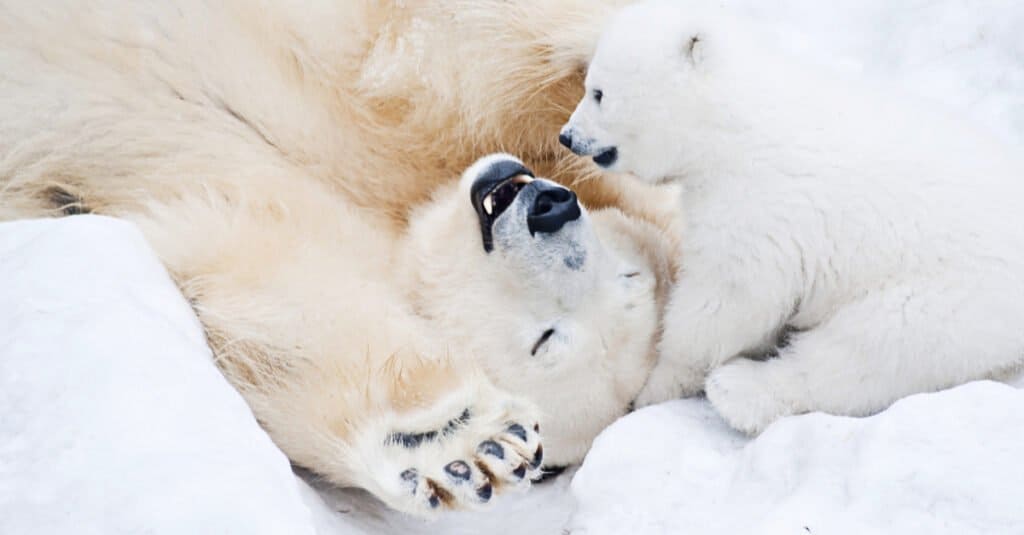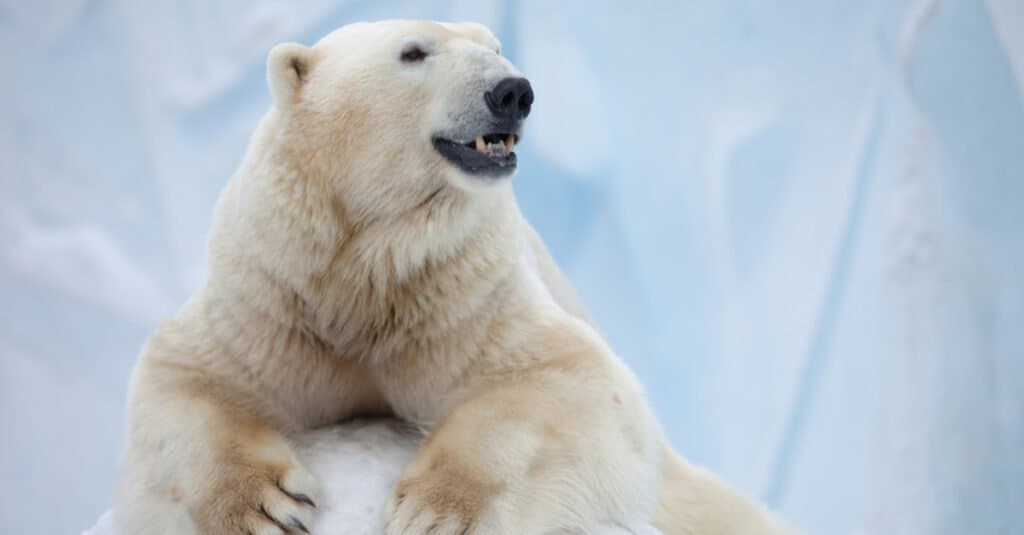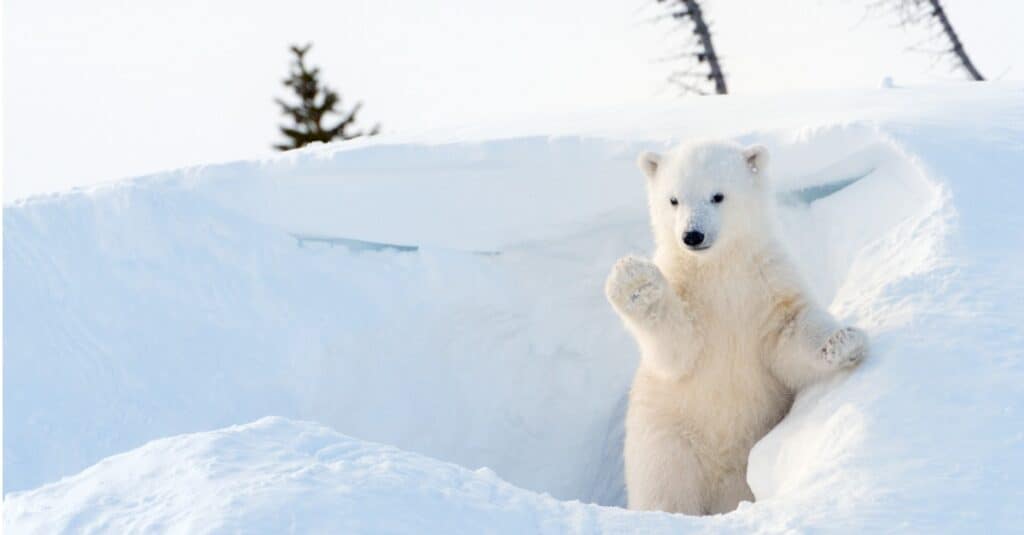
Polar bears are one of the most widely known bears throughout the world. These bears are a favorite among many people, from their thick white fur to their incredibly large claws. There’s so much more than meets the eye when it comes to polar bears. Discover all of the fascinating facts that make this bear so unique as we explore the lifespan of the polar bear.
The Rundown On Polar Bears

Polar bears can travel at speeds of up to 25 miles per hour on land and 6 miles per hour in water.
©Lamberrto/Shutterstock.com
Did you know studies have shown that polar bears derived from brown bears sometime throughout the ice ages? As the polar bears’ ancestors began to spread out along the North, they needed to make evolutionary changes in order to survive the cold.
Polar bears are native to the Arctic Circle and along the Arctic Ocean. These giant bears can weigh anywhere from 700 to 2000 pounds, females only being half the size of the males. What’s most interesting to note is that polar bears have two layers of fur, which they use to survive the cold. Temperatures in the Arctic can range between -30 to -40 degrees.
Their two-layered coats prevent them from losing any heat, sometimes working so well to the point of overheating them while engaging in physical activity. Many people also may not know that a polar bear’s fur is not actually white! The fur of a polar bear is technically considered translucent and reflects light.
Polar bears also have incredibly large paws that measure around 12 inches across. Their feet are incredibly important in their ability to trek in the snow and are used as amazing paddles when swimming throughout the ocean. A polar bear’s footpads contain small bumps known as papillae. These small bumps prevent the bear from slipping as they walk along the ice and help keep them from falling through thin layers. The claws of a polar bear can measure around 5 cm and are crucial in how they catch slippery prey such as seals.
How Long Do Polar Bears Live?

Polar bears can live up to forty years in captivity.
©Zhiltsov Alexandr/Shutterstock.com
The average polar bear’s lifespan is 20 to 30 years. In captivity, some may live up to 40, depending on diet and health. The oldest wild bear on record died at the age of 32, while the oldest in captivity died at the age of 41.
The oldest recorded polar bear in captivity was named Debby. She lived in captivity at the Assiniboine Park Zoo in Canada. Debby lived to be 41 years old but sadly passed away in 2008 due to an organ dysfunction syndrome. Guinness World Records recognized her in August 2008 as not just the oldest polar bear but also one of the three oldest individuals ever documented across all eight bear species.
Researchers can determine the age of a living polar bear by extracting one little vestigial premolar tooth. Each year, a small layer of cementum is applied to each tooth of a polar bear as it grows. The age of a tooth may be calculated by inspecting a small slice of it and counting the layers.
The Average Polar Bear Life Cycle
Now that we know a lot more information about the polar bear’s lifespan, let’s learn all about the fascinating life cycle of a polar bear! The life cycle of a polar bear consists of four different stages, starting, of course, with birth.
Birth
Polar bears tend to give birth throughout the months of November to January. Polar bear babies are known as cubs and are born deaf, blind, and with fine, not insulated, fur. A cub can weigh anywhere from 16 to 25 oz. A mother polar bear can give birth to up to 3 cubs at once but more commonly only gives birth to twins.
Childhood
The first two years of a polar bear’s life are incredibly important. The mother cub must be around her cubs at all times and never leave them unattended. When she goes hunting, she takes her cubs with her and even carries them along her back when they begin to get tired. Female polar bears also place the cubs on their back while swimming as well, since baby polar bear cubs have not developed their insulated fur yet.
Adolescence
In late March or the beginning of April, the baby cubs will begin to emerge out of their den. At this point, the cubs can properly walk on their own. However, their mothers still need to keep a close eye on them. Throughout this stage, cubs spend most of their time playing and running around. They are also breastfed by their mother until they reach three years of age and can then begin enjoying solid foods. Cubs still remain living in the den with their mothers and begin to learn from her hunting methods.
Adulthood
Once adulthood has been reached, adult polar bears traverse the Arctic on their own. They will now need to hunt, swim, and walk by themselves. Their insulated fur has fully grown in at this point. They are also equipped to survive the harsh environment of the Arctic.
What Factors Shorten A Polar Bear’s Lifespan?

Polar bears can become malnourished from a lack of prey.
©iStock.com/AndreAnita
The cause of death of polar bears in the wild is still a mystery to many researchers. This is because carcasses of wild adult polar bears are seldom found in the species’ freezing environment. Despite that, we can still determine certain factors that negatively impact their lives.
The following are the main factors that affect polar bears’ lifespan in the wild:
- Environmental factor: Climate change in the Arctic is a huge ongoing crisis. Temperature risings, shifts in the ice, and precipitation patterns play a huge role in the declining polar bear population. When the temperature rises, the ice within the sea in the Arctic begins to melt, making it harder for prey such as seals to use the ice as a platform. With less prey climbing onto the ice, this makes it much harder for polar bears to catch meals. This can lead to extremely malnourished polar bears.
- Human factor: Hunting is one of the biggest contributors to the decline in polar bears. There has been evidence of human polar bear hunts in ruins dating back 2,500 to 3,000 years. Polar bears have long been hunted for food, clothing, bedding, and religious uses by Arctic peoples.
The photo featured at the top of this post is © Gecko1968/Shutterstock.com
Thank you for reading! Have some feedback for us? Contact the AZ Animals editorial team.






